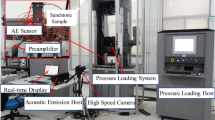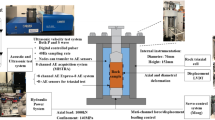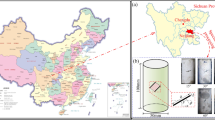Abstract
To obtain a comprehensive understanding of crack initiation and progressive failure of rock, triaxial compression testing was performed on sandstone collected from Yingjinshan area in the Qinghai-Tibet Plateau, and the spatiotemporal evolution of microcracks was analyzed using acoustic emission (AE) monitoring. Identification methods of crack initiation and crack damage stresses were compared. The local stress acting on microcracks in the rock was determined using the micromechanical homogenization method, and a crack initiation stress prediction method considering the interaction between microcracks was proposed. The results show that the peak of AE count and AE energy lags behind the peak stress under high confining pressure. When the peak stress is approached, there is a sudden increase in the number of AE locating points. The initiation and propagation of numerous new cracks after the peak cause violent AE activity. The accuracy of crack initiation stress of sandstone identified using strain-based method is higher than that identified using AE energy rate method. The relationship between crack initiation stress and confining pressure is linear for sandstone. The crack initiation stress level increases as friction coefficient increases, and presents a U-shaped symmetrical distribution with the crack azimuth angle. The most vulnerable crack set decreases with increase in friction coefficient. With increase in crack length, crack initiation stress level, and ratio of compressive-tensile strength, the most vulnerable crack set gradually increases. These research results provide a meaningful reference for identification of crack characteristic stress, prediction of damage deterioration range and stability evaluation of tunnel surrounding rock.
Highlights
-
An improved prediction model for rock crack initiation stress is established, which overcomes the limitation of previous models that lack consideration of the interaction between microcracks.
-
The crack initiation stress level presents a U-shaped symmetrical distribution with the crack azimuth angle.
-
The most vulnerable crack set decreases with increase in friction coefficient, but it increases nonlinearly with increase in crack length, crack initiation stress level, and ratio of compressive-tensile strength.










Similar content being viewed by others
Abbreviations
- a :
-
Semi-length of crack (mm)
- E :
-
Elastic modulus (MPa)
- D :
-
Diameter (mm)
- H :
-
Height (mm)
- c :
-
Cohesion (MPa)
- f :
-
Friction coefficient of crack face
- K I :
-
Mode I stress intensity factor (MPa m0.5)
- K II :
-
Mode II stress intensity factor (MPa m0.5)
- K II C :
-
Fracture toughness (MPa m0.5)
- d :
-
Semi-opening of crack (mm)
- C 0 :
-
Elastic tensor of rock matrix material (MPa)
- C c :
-
Elastic tensor of microcrack phase material (MPa)
- Chom :
-
Equivalent elastic tensor of heterogeneous matrix inclusion material (MPa)
- A c :
-
Strain concentration tensor
- K 0 :
-
Bulk modulus of rock matrix (MPa)
- G 0 :
-
Shear modulus of rock matrix (MPa)
- S :
-
Spherical matrix Eshelby tensor
- B c :
-
Local stress field concentration factor
- σ 3 :
-
Confining pressure (MPa)
- σ c :
-
Peak stress (MPa)
- σ ci :
-
Crack initiation stress (MPa)
- σ cd :
-
Crack damage stress (MPa)
- σ cu :
-
Uniaxial compressive strength (MPa)
- σ t :
-
Uniaxial tensile strength (MPa)
- θ :
-
Crack initiation angle (°)
- α :
-
Crack azimuth angle (°)
- ψ :
-
Most vulnerable crack set (°)
- α m :
-
Crack preponderant azimuth angle (°)
- ω :
-
Crack aspect ratio
- ρ :
-
Crack density parameter
- σ l :
-
Local stress acting on the spherical matrix (MPa)
- σ :
-
Far-field stress (MPa)
- ε 0 pt :
-
Strain difference between the spherical matrix and the M–T equivalent medium
- ε * :
-
Intrinsic strain
- σ pt :
-
Stress difference between spherical matrix and M–T equivalent medium (MPa)
- σ li :
-
Local principal stress (MPa)
- σ i :
-
Far-field principal stress (MPa)
- σ l1 :
-
Local axial stress (MPa)
- σ l3 :
-
Local lateral stress (MPa)
References
Ai T, Zhang R, Liu J, Ren L (2012) Space–time evolution rules of acoustic emission location of unloaded coal sample at different loading rates. Int J Min Sci Technol 22(6):847–854. https://doi.org/10.1016/j.ijmst.2012.12.001
Ashby M, Hallam S (1986) The failure of brittle solids containing small cracks under compressive stress state. Acta Metall 34(3):497–510. https://doi.org/10.1016/0001-6160(86)90086-6
Ashby M, Sammis C (1990) The damage mechanics of brittle solids in compression. Pure Appl Geophys 133(3):489–521. https://doi.org/10.1007/BF00878002
Bao H, Pei R, Lan H, Yan C, Xu J, Zhai Y, Xu X (2021) Damage evolution of biotite quartz schist caused by mineral directional arrangement under cyclic loading and unloading. Chin J Rock Mech Eng 40(10):2015–2026. https://doi.org/10.13722/j.cnki.jrme.2021.0410
Baud P, Wong T-f, Zhu W (2014) Effects of porosity and crack density on the compressive strength of rocks. Int J Rock Mech Min Sci 67(4):202–211. https://doi.org/10.1016/j.ijrmms.2013.08.031
Benveniste Y (1986) On the Mori-Tanaka’s method in cracked bodies. Mech Res Commun 13(4):193–201. https://doi.org/10.1016/0093-6413(86)90018-2
Brace WF, Paulding BW, Scholz C (1966) Dilatancy in the fracture of crystalline rocks. J Geophys Res 71(16):3939–3953. https://doi.org/10.1029/JZ071i016p03939
Browning J, Meredith PG, Stuart CE, Healy D, Harland S, Mitchell TM (2017) Acoustic characterization of crack damage evolution in sandstone deformed under conventional and true triaxial loading. J Geophys Res-Sol Earth 122(6):4395–4412. https://doi.org/10.1002/2016jb013646
Bruning T, Karakus M, Nguyen G, Goodchild D (2018) Experimental study on the damage evolution of Brittle rock under triaxial confinement with full circumferential strain control. Rock Mech Rock Eng 51(11):1–21. https://doi.org/10.1007/s00603-018-1537-7
Cai M (2009) Practical estimates of tensile strength and hoek-brown strength parameter MI of Brittle rocks. Rock Mech Rock Eng 43(2):167–184. https://doi.org/10.1007/s00603-009-0053-1
Cai M, Kaiser PK, Tasaka Y, Maejima T, Morioka H, Minami M (2004) Generalized crack initiation and crack damage stress thresholds of brittle rock masses near underground excavations. Int J Rock Mech Min Sci 41(5):833–847. https://doi.org/10.1016/j.ijrmms.2004.02.001
Deng H, Zhu M, Li J, Wang Y, Luo Q, Yuan X (2012) Study of mode-I fracture toughness and its correlation with strength parameters of sandstone. Rock Soil Mech 33(12):3585–3591. https://doi.org/10.16285/j.rsm.2012.12.004
Dey TN, Wang CY (1981) Some mechanisms of microcrack growth and interaction in compressive rock failure. Int J Rock Mech Min Sci Geomech Abstr 18(3):199–209. https://doi.org/10.1016/0148-9062(81)90974-8
Diederichs M (2007) The 2003 Canadian Geotechnical colloquium: mechanistic interpretation and practical application of damage and spalling prediction criteria for deep tunneling. Can Geotech J 44(9):1082–1116. https://doi.org/10.1139/T07-033
Diederichs MS, Kaiser PK, Eberhardt E (2004) Damage initiation and propagation in hard rock during tunnelling and the influence of near-face stress rotation. Int J Rock Mech Min Sci 41(5):785–812. https://doi.org/10.1016/j.ijrmms.2004.02.003
Eberhardt E (1998) Brittle rock fracture and progressive damage in uniaxial compression. In: Ph.D. thesis, University of Saskatchewan
Eberhardt E, Stead D, Stimpson B, Read RS (1997) Changes in acoustic event properties with progressive fracture damage. Int J Rock Mech Min Sci 34(3):71.e71-71.e12. https://doi.org/10.1016/S0148-9062(97)00284-2
Ergodan F, Sih GC (1963) On the crack extension in plates under plane loading and transverse shear. ASME J Basic Eng 85:525–527
Feng X, Chen S, Zhou H (2004) Real-time computerized tomography (CT) experiments on sandstone damage evolution during triaxial compression with chemical corrosion. Int J Rock Mech Min Sci 41(2):181–192. https://doi.org/10.1016/s1365-1609(03)00059-5
Feng G, Wang X, Kang Y, Zhang Z (2020a) Effect of thermal cycling-dependent cracks on physical and mechanical properties of granite for enhanced geothermal system. Int J Rock Mech Min Sci 134:104476. https://doi.org/10.1016/j.ijrmms.2020.104476
Feng G, Wang X, Wang M, Kang Y (2020b) Experimental investigation of thermal cycling effect on fracture characteristics of granite in a geothermal-energy reservoir. Eng Fract Mech 235(7):107180. https://doi.org/10.1016/j.engfracmech.2020.107180
Fonseka GM, Murrell SAF, Barnes P (1985) Scanning electron microscope and acoustic emission studies of crack development in rocks. Int J Rock Mech Min Sci Geomech Abstr 22:273–289. https://doi.org/10.1016/0148-9062(85)92060-1
He R, Ren L, Zhang R, Zhu Z, Sun X (2022) Anisotropy characterization of the elasticity and energy flow of Longmaxi shale under uniaxial compression. Energy Rep 8:1410–1424. https://doi.org/10.1016/j.egyr.2021.12.050
Horii H, Nemat-Nasser S (1983) Overall moduli of solids with microcracks: Load-induced anisotropy. J Mech Phys Solids 32(8):155–171. https://doi.org/10.1016/0022-5096(83)90048-0
Hu G, Zhao C, Chen N, Chen K, Wang T (2019) Characteristics, mechanisms and prevention modes of debris flows in an arid seismically active region along the Sichuan-Tibet railway route, China: a case study of the Basu-Ranwu section, southeastern Tibet. Environ Earth Sci 78:18. https://doi.org/10.1007/s12665-019-8554-z
Jia Z et al (2020) Acoustic emission characteristics and damage evolution of coal at different depths under triaxial compression. Rock Mech Rock Eng 53(5):2063–2076. https://doi.org/10.1007/s00603-019-02042-w
Kang ZQ, Yu Y, Wen HM (2011) Damage evolution of rock and acoustic emission study about deep diversion tunnel in the excavation process. Adv Mat Res 366:243–246. https://doi.org/10.4028/www.scientific.net/AMR.366.243
Kim J-S, Lee K-S, Cho W-J, Choi H-J, Cho G-C (2014) A comparative evaluation of stress-strain and acoustic emission methods for quantitative damage assessments of Brittle rock. Rock Mech Rock Eng 48(2):495–508. https://doi.org/10.1007/s00603-014-0590-0
Lajtai E (1974) Brittle fracture in compression. Int J Fract 10(4):525–536. https://doi.org/10.1007/BF00155255
Li S et al (2014) Electrical resistivity and acoustic emission response characteristics and damage evolution of sandstone during whole process of uniaxial compression. Chin J Rock Mech Eng 33(1):14–23. https://doi.org/10.13722/j.cnki.jrme.2014.01.002
Li C, Xie H, Xie L (2017) Experimental and theoretical study on the shale crack initiation stress and crack damage stress. J China Coal Soc 42(4):969–976. https://doi.org/10.13225/j.cnki.jccs.2015.1472
Li C, Xie H, Wang J (2020) Anisotropic characteristics of crack initiation and crack damage thresholds for shale. Int J Rock Mech Min Sci 126(14):104178. https://doi.org/10.1016/j.ijrmms.2019.104178
Liu B, Huang J, Wang Z, Liu L (2009) Study on damage evolution and acoustic emission character of coal-rock under uniaxial compression. Chin J Rock Mech Eng 28(S1):3234–3238
Liu Q, Wei L, Lei G, Liu Q, Peng X, Liu H (2018) Experimental study on damage strength of crack initiation and evaluation of brittle parameters of sandstone Chin J. Geotech Eng 40(10):1782–1789. https://doi.org/10.11779/CJGE201810004
Lv J, Wang Z, Liu H (2012) Fracture and damage of rock. Geological Publishing House, China
Ma SP, Wang LG, Jin GC (2006) Damage evolution inspection of rock using digital speckle correlation method (DSCM). Key Eng Mater 326–328:1117–1120. https://doi.org/10.4028/www.scientific.net/KEM.326-328.1117
Mark K (1992) Effective elastic properties of cracked solids: critical review of some basic concepts. Appl Mech Rev 45(8):304–335. https://doi.org/10.1115/1.3119761
Martin CD, Chandler NA (1994) The progressive fracture of Lac du Bonnet granite. Int J Rock Mech Min Sci Geomech 31(6):643–659. https://doi.org/10.1016/0148-9062(94)90005-1
Martin CD, Christiansson R (2009) Estimating the potential for spalling around a deep nuclear waste repository in crystalline rock. Int J Rock Mech Min Sci 46(2):219–228. https://doi.org/10.1016/j.ijrmms.2008.03.001
Meng Q, Zhang M, Han L, Pu H, Nie T (2016) Effects of acoustic emission and energy evolution of rock specimens under the uniaxial cyclic loading and unloading compression. Rock Mech Rock Eng 49(10):3873–3886. https://doi.org/10.1007/s00603-016-1077-y
Mori T, Tanaka K (1973) Average stress in matrix and average elastic energy of materials with misfitting inclusions. Acta Metall 21(5):571–574. https://doi.org/10.1016/0001-6160(73)90064-3
Nicksiar M, Martin CD (2012) Evaluation of methods for determining crack initiation in compression tests on low-porosity rocks. Rock Mech Rock Eng 45(4):607–617. https://doi.org/10.1007/s00603-012-0221-6
O’Connell RJ, Budiansky B (1974) Seismic velocities in dry and saturated cracked solids. J Geophys Res 79(35):5412–5426. https://doi.org/10.1029/JB079i035p05412
Peng Z, Wang Y, Li T (1996) Griffih theory and the criteria of rock burst. Chin J Rock Mech Eng 4(s1):491–495
Ren J (2001) Real-time ct monitoring for the meso-damage propagation characteristics of rock under triaxial compression. J Exp Mech 16(4):387–395
Sammis C, Ashby M (1986) The failure of brittle porous solids under compressive stress states. Acta Metall 34(3):511–526. https://doi.org/10.1016/0001-6160(86)90087-8
Sih GC (1974) Strain-energy-density factor applied to mixed mode crack problems. Int J Fract 10(3):305–321. https://doi.org/10.1007/BF00035493
Song H, Zhang H, Kang Y, Huang G, Fu D, Qu C (2013) Damage evolution study of sandstone by cyclic uniaxial test and digital image correlation. Tectonophysics 608(26):1343–1348. https://doi.org/10.1016/j.tecto.2013.06.007
Stacey TR (1981) A simple extension strain criterion for fracture of brittle rock. Int J Rock Mech Min Sci Geomech Abstr 18(6):469–474. https://doi.org/10.1016/0148-9062(81)90511-8
Sun X, Li E, Duan J, Pu S, Tan Y, Han Y, Zhao Y (2018) Study on acoustic emission characteristics and damage evolution law of Beishan granite under triaxial compression. Chin J Rock Mech Eng 37(S2):4234–4244. https://doi.org/10.13722/j.cnki.jrme.2018.0634
Tang L, Wang W (2002) New Rock Burst Proneness Index. Chin J Rock Mech Eng 4(6):874–878
Tham LG, Liu H, Tang CA, Lee PKK, Tsui Y (2004) On tension failure of 2-D rock specimens and associated acoustic emission. Rock Mech Rock Eng 38(1):1–19. https://doi.org/10.1007/s00603-004-0031-6
Wang Y, Li X, Wu Y, Ben Y, Li S, Jianming H, Zhang B (2014) Research on relationship between crack initiation stress level and brittleness indices for Brittle rocks. Chin J Rock Mech Eng 33(2):264–275. https://doi.org/10.13722/j.cnki.jrme.2014.02.003
Wang Y, Wang H, Zhou X, Yi X, Xiao Y, Wei X (2019) In situ X-ray ct investigations of meso-damage evolution of cemented waste rock-tailings backfill (CWRTB) during triaxial deformation. Minerals 9(1):52. https://doi.org/10.3390/min9010052
Wu S, Ge H, Wang X, Meng F (2017) Shale failure processes and spatial distribution of fractures obtained by AE monitoring. J Nat Gas Sci Eng 41:82–92. https://doi.org/10.1016/j.jngse.2017.02.015
Xie HP, Liu JF, Ju Y, Li J, Xie LZ (2011) Fractal property of spatial distribution of acoustic emissions during the failure process of bedded rock salt. Int J Rock Mech Min Sci 48(8):1344–1351. https://doi.org/10.1016/j.ijrmms.2011.09.014
Yang Y, Wang D, Guo M, Li B (2014) Study of rock damage characteristics based on acoustic emission tests under triaxial compression. Chin J Rock Mech Eng 33(1):98–104. https://doi.org/10.13722/j.cnki.jrme.2014.01.008
Yang X, Weng L, Hu Z (2018) Damage evolution of rocks under triaxial compressions: an NMR Investigation. KSCE J Civ Eng 22(8):2856–2863. https://doi.org/10.1007/s12205-017-0766-8
Yao H, Chen J, Nie X, Huang R, Wang J, Li Y (2020a) Evolution of shale damage in uniaxial compression acoustic emission tests. Sci Technol Eng 20(4):1581–1586
Yao W, Xu Y, Xia K (2020b) Damage evolution during rock pulverization induced by dynamic compressive loading. J Geophys Res-Sol Earth 125:5. https://doi.org/10.1029/2020jb019388
Yuan RF, Li YH (2009) Fractal analysis on the spatial distribution of acoustic emission in the failure process of rock specimens. Int J Min Met Mater 16(1):21–26. https://doi.org/10.1016/S1674-4799(09)60004-2
Zhang Z (2002) An empirical relation between mode I fracture toughness and the tensile strength of rock. Int J Rock Mech Min Sci 39(3):401–406. https://doi.org/10.1016/S1365-1609(02)00032-1
Zhang Q (2013) Numerical modeling of coupled thermo-mechanical-damage behaviors for brittle rocks. In: Ph.D.Thesis, Wuhan University
Zhang R, Dai F, Gao MZ, Xu NW, Zhang CP (2015a) Fractal analysis of acoustic emission during uniaxial and triaxial loading of rock. Int J Rock Mech Min Sci 79:241–249. https://doi.org/10.1016/j.ijrmms.2015.08.020
Zhang Z, Zhang R, Xie H, Liu J, Were P (2015b) Differences in the acoustic emission characteristics of rock salt compared with granite and marble during the damage evolution process. Environ Earth Sci 73(11):6987–6999. https://doi.org/10.1007/s12665-015-4406-7
Zhang R, Ai T, Ren L, Li G (2018) Failure characterization of three typical coal-bearing formation rocks using acoustic emission monitoring and X-ray computed tomography techniques. Rock Mech Rock Eng 52(6):1945–1958. https://doi.org/10.1007/s00603-018-1677-9
Zhang Y, Wu W, Yao X, Liang P, Tian B, Hang Y, Liang J (2020a) Acoustic emission, infrared characteristics and damage evolution of granite under uniaxial compression. Rock Soil Mech 41(S1):139–146. https://doi.org/10.16285/j.rsm.2019.0305
Zhang Z, Xie H, Zhang R, Gao M, Ai T, Zha E (2020b) Size and spatial fractal distributions of coal fracture networks under different mining-induced stress conditions. Int J Rock Mech Min Sci 132(1):104364. https://doi.org/10.1016/j.ijrmms.2020.104364
Zhang A, Xie H, Zhang R, Ren L, Zhou J, Gao M, Tan Q (2021) Dynamic failure behavior of Jinping marble under various preloading conditions corresponding to different depths. Int J Rock Mech Min Sci 148:104959. https://doi.org/10.1016/j.ijrmms.2021.104959
Zhang A et al (2022a) Energy characteristics and micro-cracking behaviors of deep slate rock under triaxial loadings. Acta Geophys. https://doi.org/10.1007/s11600-022-00810-x
Zhang R et al (2022b) Excavation-induced structural deterioration of rock masses at different depths. Arch Civ Mech Eng 22(2):1–15. https://doi.org/10.1007/s43452-022-00401-z
Zhao XG, Cai M, Wang J, Ma LK (2013) Damage stress and acoustic emission characteristics of the Beishan granite. Int J Rock Mech Min Sci 64(12):258–269. https://doi.org/10.1016/j.ijrmms.2013.09.003
Zhou H, Meng F, Lu JJ, Zhang CS, Yang FJ (2014) Discussion on methods for calculating crack initiation strength and crack damage strength for hard rock. Rock Soil Mech 35(4):913–925. https://doi.org/10.16285/j.rsm.2014.04.002
Zhu Q (2019) Multiscale rock damage mechanics. Science Press, Beijing
Acknowledgements
Financial supports from the National Natural Science Foundation of China under Grant No. 52125402, the Natural Science Foundation of Sichuan Province, China under Grant No. 2022NSFSC0005, and the Research Project of China Railway Eryuan Engineering Group Company, Ltd. under Grant No. 19H0537 are gratefully acknowledged.
Author information
Authors and Affiliations
Corresponding authors
Additional information
Publisher's Note
Springer Nature remains neutral with regard to jurisdictional claims in published maps and institutional affiliations.
Rights and permissions
Springer Nature or its licensor holds exclusive rights to this article under a publishing agreement with the author(s) or other rightsholder(s); author self-archiving of the accepted manuscript version of this article is solely governed by the terms of such publishing agreement and applicable law.
About this article
Cite this article
Wang, X., Xie, H., Zhang, R. et al. Progressive Failure Characterization of Sandstone from Yingjinshan Area in Qinghai-Tibet Plateau. Rock Mech Rock Eng 55, 6723–6740 (2022). https://doi.org/10.1007/s00603-022-02999-1
Received:
Accepted:
Published:
Issue Date:
DOI: https://doi.org/10.1007/s00603-022-02999-1




